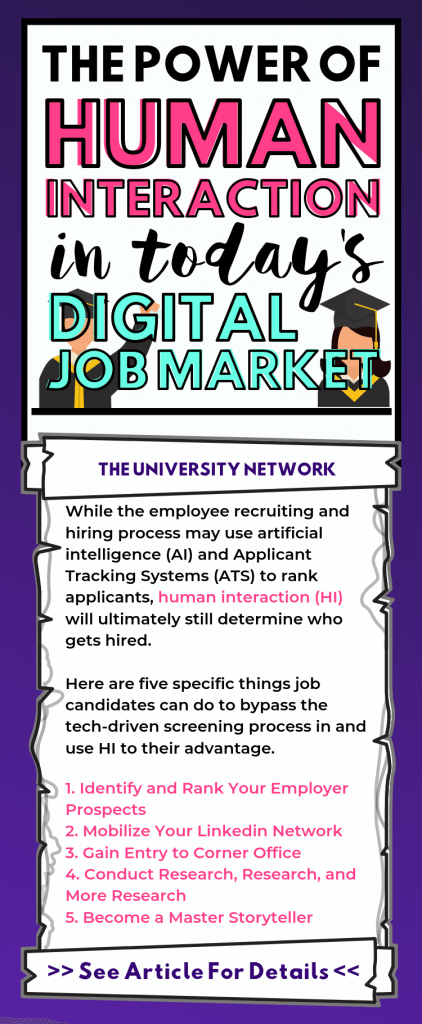You just walked across the stage and received your diploma. As you start to celebrate this incredible life milestone, this is the question you are asked time and again by family and friends, “So, do you have a job?”
As a professor of public relations at Rutgers University, I collaborate annually with hundreds of college students in an effort to help them develop their brand narrative, evolve their professional network, apply for job openings, prepare for interviews and secure that first job after graduation, making their successful transition from college to a career.
However, in today’s digital market, the job application and interview process no longer prioritizes human contact. The employer recruiting and hiring process has transformed over the past decade into an increasingly challenging hi-tech jigsaw puzzle that graduates need to solve.
As Beth Galetti, vice president of human relations at Amazon, said in an interview with Fast Company, “If we are going to hire tens of thousands of people a year – or now hundreds of thousands – we can’t afford to live by manual processes and manual transactions.”
Amazon and the majority of employers today may leverage technology to recruit, screen and interview job candidates, but college graduates can’t afford to bet their future career exclusively on today’s digital-centric hiring process. Instead, they should set a proactive strategy and invest in a human relations approach to counter today’s digital and tech market.
While the employee recruiting and hiring process may use artificial intelligence (AI) and Applicant Tracking Systems (ATS) to rank applicants, human interaction (HI) will ultimately determine who gets hired.
According to a University of Michigan study, the odds of an individual getting a job via an online job site application, which typically utilizes ATS, is just 1 out of 250. However, if an individual takes more of a HI approach to job-seeking, employee referrals only make up 7 percent of applications, but 40 percent of hires. In other words, if an applicant leverages and mobilizes their network, they will drastically improve their chances of securing a job than if they solely rely on today’s tech innovations that are screening candidates and oftentimes eliminating the best person for the job.
Here are five specific things job candidates can do to bypass the tech-driven screening process in today’s digital market and use HI to their advantage.

1. Identify and rank your employer prospects
Rank the top 25 companies where you want to work. Take a strategic approach to securing your job rather than just applying online to every job posting you come across. Based on your area of study and your passions, draw a circle from your anticipated residential location to as many miles around as you are willing to commute. Once your circle is complete, identify and plot 25 companies, agencies and organizations, including non-profits that match your interests.
2. Mobilize your LinkedIn network
Once you have your 25 employer prospects, mobilize all the human connections in your network of family, friends, neighbors, professors, mentors and past internship supervisors, and don’t forget all those contacts you have compiled on LinkedIn. Proactively conduct outreach to your contacts with the goal of identifying just one contact each of them has with one of those 25 companies you have ranked, and have them make a personal introduction by phone, email or face-to-face conversation.
3. Gain entry to corner office
Once individuals in your network make an introduction for you with someone at one of your 25 prospects, gain entry to his or her office by requesting a cup-of-coffee conversation. Your mission is to gain access, walk the halls and conduct your own research and reconnaissance. If you successfully accomplish this step in the process, you have just gained entry into the place where you ultimately want to be employed.
4. Conduct research, research and more research
This may be the most critical step in your process to get employed. You need to research the individuals you are about to meet and the company they work for in the same manner you prepared for the most important exam of your college career. You want to know everything about these individuals — the college they attended, where they worked prior to their current company, their time in the local 5K run last weekend, and even what content they shared on Instagram and Twitter over the past month. You will need to use all of it to your advantage to ace the final test.
5. Become a master storyteller
You now have just one very important objective — to impress the individuals you are having a cup of coffee with so much that they walk you and your resume down the hall to human resources and the recruiting manager. In order to do that, you need to be confident and articulate, and fully leverage all that research you conducted. This is where the art of human interaction comes into play. While you are not being formally interviewed, on this day, you do need to become a master storyteller and share your experience, unique value proposition and point-of-difference in the most compelling manner.
Technology will play a significant role in your transition from college to the first stop in your career. However, by taking a HI approach to securing your first job after graduation, you minimize the influence of AI, ATS and other digital platforms, putting you in the driver’s seat for the journey through the job application, screening, vetting and interview process.
[simple-author-box]



